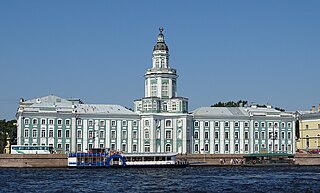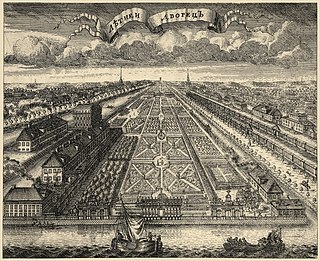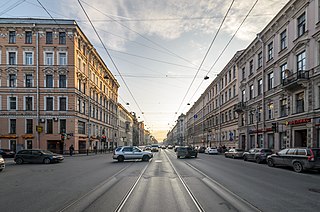
Catherine IAlekseevna Mikhailova was the second wife and Empress consort of Peter the Great, whom she succeeded as Empress of Russia, ruling from 1725 until her death in 1727.

The Moscow Kremlin, or simply the Kremlin, is a fortified complex in Moscow, Russia. Located in the centre of the country's capital city, it is the best known of the kremlins and includes five palaces, four cathedrals, and the enclosing Kremlin Wall along with the Kremlin towers. Within the complex is the Grand Kremlin Palace, which served as the royal residence of the Emperor of Russia. It is now the official residence of the President of the Russian Federation. The Kremlin overlooks the Moskva River to the south, Saint Basil's Cathedral and Red Square to the east, and Alexander Garden to the west.

Kolomenskoye is a former royal estate situated several kilometers to the southeast of the city center of Moscow, Russia, on the ancient road leading to the town of Kolomna. The 390 hectare scenic area overlooks the steep banks of the Moskva River. It became a part of Moscow in the 1960s.

The Kunstkamera or Kunstkammer is a public museum located on the Universitetskaya Embankment in Saint Petersburg, facing the Winter Palace. Its collection was first opened to the public at the Summer Palace by Peter the Great in 1714, making it Russia's first museum. Enlarged by purchases from the Dutch collectors Albertus Seba and Frederik Ruysch, the museum was moved to its present location in 1727. Having expanded to nearly 2,000,000 items, it is formally organized as the Russian Academy of Science's Peter the Great Museum of Anthropology and Ethnography, abbreviated in Russian as the МАЭ or МАЭ РАН.

The Summer Garden is a historic public garden that occupies an eponymous island between the Neva, Fontanka, Moika, and the Swan Canal in downtown Saint Petersburg, Russia and shares its name with the adjacent Summer Palace of Peter the Great. Its inception dates back to the early 18th century when Russia took these lands from Sweden in the Great Northern War. Being a monument of landscape architecture featuring original and copied sculptures of classical mythology characters, a former royal palace and a monument to the fable author Ivan Krylov, the garden is now a branch of the Saint Petersburg-based national art treasury Russian Museum.

Liteyny Avenue is a wide avenue in the Central District of Saint Petersburg, Russia. The avenue runs from Liteyny Bridge to Nevsky Avenue.

Saint Andrew's Cathedral was the last Baroque cathedral built in Saint Petersburg, Russia.

The Peter the Great egg is a jewelled Easter egg made under the supervision of the Russian jeweler Peter Carl Fabergé in 1903 for the last Tsar of Russia, Nicholas II. Tsar Nicholas presented the Fabergé egg to his wife, the Czarina Alexandra Fyodorovna. The egg is currently located at the Virginia Museum of Fine Arts in Richmond, Virginia, in the United States.
Events from the year 1703 in art.

The city of Saint Petersburg was founded by Tsar Peter the Great on 27 May 1703. It became the capital of the Russian Empire and remained as such for more than two hundred years. Saint Petersburg ceased being the capital in 1918 after the October Coup.

The Winter Palace is a palace in Saint Petersburg that served as the official residence of the House of Romanov, previous emperors, from 1732 to 1917. The palace and its precincts now house the Hermitage Museum. Floor area is 233,345 square metres.. Total area of the Winter Palace is 14.2 hectares. Situated between Palace Embankment and Palace Square, adjacent to the site of Peter the Great's original Winter Palace, the present and fourth Winter Palace was built and altered almost continuously between the late 1730s and 1837, when it was severely damaged by fire and immediately rebuilt. The storming of the palace in 1917, as depicted in Soviet art and in Sergei Eisenstein's 1928 film October, became a symbol of the October Revolution.

The Pushkin House, formally the Institute of Russian Literature, is a research institute in St. Petersburg. It is part of a network of institutions affiliated with the Russian Academy of Sciences.

The Neva Enfilade of the Winter Palace, St Petersburg, is a series of three large halls arranged in an enfilade along the palace's massive facade facing the River Neva.

The Summer Palace of Peter the Great was built in Saint Petersburg between 1710 and 1714 in the northeast corner of the Summer Garden, located on an island formed by the Fontanka River, Moyka River, and the Swan Canal. Its northern perimeter runs along the left bank of the Neva River across from the Cabin of Peter the Great and Peter and Paul Fortress and was the first palace built in Saint Petersburg, the second largest city in Russia.

The Chesme Church, is a small Russian Orthodox church at 12 Lensoveta Street, in Saint Petersburg, Russia. It was built by the Russian court architect Yury Felten in 1780, at the direction of Catherine the Great, Empress of Russia. A memorial church, it was erected adjacent to the Chesme Palace between Saint Petersburg and Tsarskoye Selo to commemorate the anniversary of Russia's 1770 victory over Turkish forces in Chesme Bay in the Aegean Sea during the Russo-Turkish War of 1768–1774.

The Private Apartments of the Winter Palace are sited on the piano nobile of the western wing of the former imperial palace, the Winter Palace in St Petersburg. Access to the private rooms, for members of the imperial family, from the exterior was usually through the Saltykov Entrance which was reserved for use by only the Tsar, Tsaritsa and grand dukes and grand duchesses. A second access was through a discrete box-like porch, on the western end of the palace's Neva façade. From the ground floor, it can be accessed from the October Staircase, formerly known as His Majesty's Own Staircase; this double-flighted imperial staircase was a secondary entrance to the private apartments, and provided a more convenient route to the palace's ground floor and private entrances than the more formal and ceremonial public route through the state apartments. During the October Revolution of 1917, this was the entrance by which the revolutionaries gained access to the palace in order to arrest the Provisional Government in the small private dining room. Since that date it has been known as the October Staircase and has a plaque commemorating the event. Despite its size and grandeur, the October Staircase was a secondary staircase, the Jordan Staircase being the principal.
The following is a timeline of the history of the city of Saint Petersburg, Russia.

St. Catherine's Armenian Church is an Armenian Apostolic church on Nevsky Prospect, in central Saint Petersburg, Russia. Built in the 1770s, it is one of the earliest Armenian churches in Russia.

Count Pyotr Grigoryevich Chernyshev was a Russian Imperial nobleman, diplomat, privy counsellor, chamberlain, and senator.

The Fountain House is a palace in Russia built by the Sheremetev family, named after the nearby Fontanka river. Since its erection in 1712 the building was reconstructed several times by famous architects G. Dmitryev, Savva Chevakinsky, Fyodor Argunov, and Ivan Starov. It is also known as the Sheremetev Palace.



















